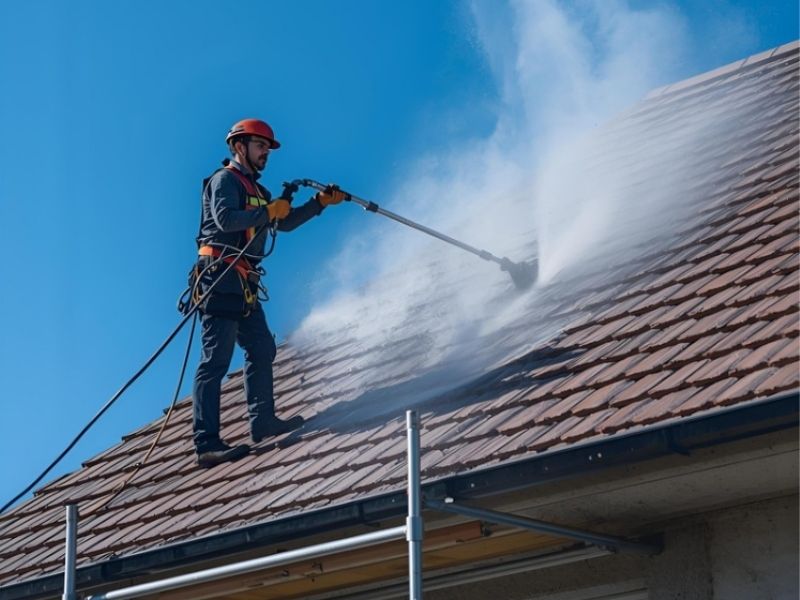
When moss and algae take hold of your roof tiles, two main cleaning methods compete for your attention: roof steam cleaning and the traditional roof scraping approach. We at Roof Cleaning Newcastle have tested both techniques across hundreds of domestic and commercial properties. The key differences between these methods affect not just your initial cost, but how long your clean roof stays that way.
Roof scraping involves manual removal using wire brushes, physical tools, and scrapers. Workers climb up and systematically scrape moss from the roof's surface by hand. This cleaning process is straightforward but labour intensive, leaving many homeowners to consider what type of roof cleaning is best for their property and budget.
Roof steam cleaning takes a different path. Hot water vapour is applied at low pressure, killing moss algae and other organic growth at the cellular level. Unlike scraping, this method destroys moss spores and algae spores without aggressive contact with the roof's surface.
The statistics tell a clear story. Steam cleaning keeps roofs clear for 4 to 6 years by killing growth at the root. Roof scraping alone typically maintains results for just 6 to 12 months because stubborn moss roots remain alive underground.
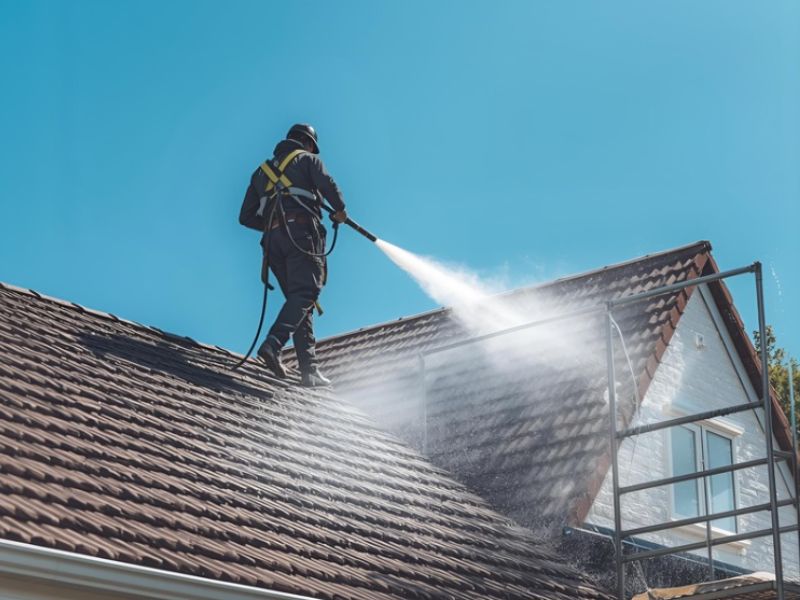
The scraping method starts with accessing your roof safely using ladders or scaffolding. Professionals use specialized tools including scrapers and wire brushes to lift moss and lichen from concrete tiles, slate tiles, and other roof materials.
This cleaning process works fast for removing visible bulk. A roof can hold hundreds of kilograms of moss and grime. Manual removal clears this weight effectively, improving drainage and preventing water ingress through compromised tiles.
But roof scraping has limitations. Scraping moss removes what you see without addressing microscopic remaining spores left behind. Within months, moss growth resumes. The physical tools also create risks. Workers spend considerable time directly on the roof's surface, which increases chances of tile damage. Fragile roofs with older materials face the highest risk.
Many professional roof teams pair scraping with chemical treatments. A biocide treatment applied after manual removal extends cleanliness for 3 to 5 years. This combination brings results closer to steam cleaning effectiveness, though chemical solutions raise environmental concerns.
Professional roof steam cleaning uses specialised equipment that heats water to extreme temperatures. The resulting steam penetrates moss and algae, destroying them from within. This method kills moss spores and algae spores, preventing the rapid regrowth that plagues scraping alone.
The technique relies on low pressure water delivery rather than high pressure water or pressure washing. Standard pressure washing can damage tiles, but steam cleaning uses low pressure water heated to high temperatures instead. This makes it one of the safest cleaning methods for delicate slate tiles and clay roof types.
We've found that roof steam cleaning transforms appearance dramatically. The hot water lifts stubborn moss at its base and removes surface staining that manual removal misses. After treatment, the roof remains looking close to new for years.
Unlike scraping, steam cleaning allows workers to use telescopic poles and work from scaffolding for hard to reach areas. This minimises foot traffic on tiles and protects structural integrity. The damage free roof cleaning approach prevents the accidental cracking common with pressure washer equipment or aggressive scraping.
Initial cost differences matter to most homeowners. Roof scraping typically costs less upfront because it's faster and requires less specialised equipment. Professional roof cleaning using steam can cost 10 to 20 percent more due to the technology involved, and many homeowners often ask how much does roof cleaning cost in Newcastle when comparing these options.
But cost effective choices consider longevity. Scraping might need repeating annually or biennially. Steam cleaning keeps moss and algae away for several years, reducing roof maintenance frequency. When you calculate expenses over time, the higher initial cost of steam cleaning often proves more economical.
Property owners planning long term occupancy find steam cleaning delivers better value. The extended protection prevents costly repairs from water ingress and tile damage. Regular maintenance becomes less time consuming and less expensive overall.
For those preparing properties for sale, roof scraping offers quick improvement of the home's curb appeal at lower immediate expense. This makes it popular as a fast solution before marketing a property.
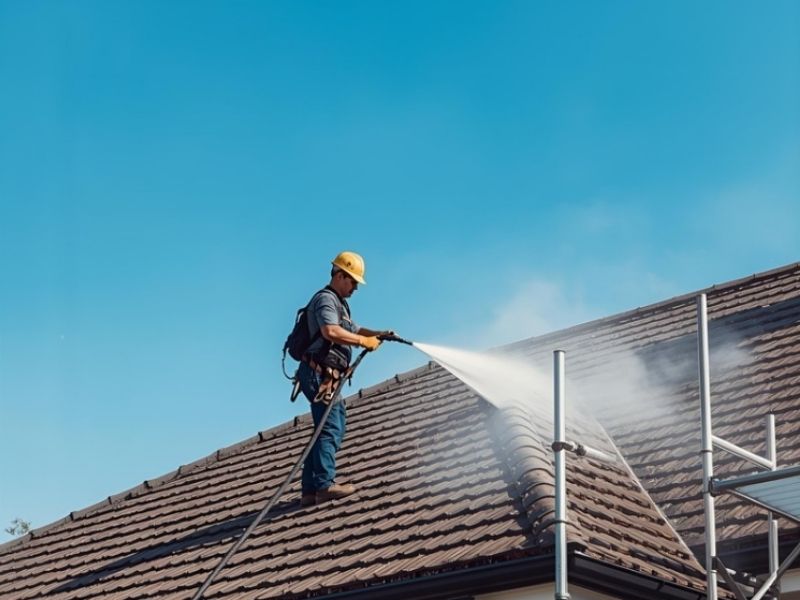
Your roof material determines which cleaning methods work best. Asphalt shingles handle both approaches reasonably well. Concrete tiles withstand scraping but benefit from the gentler touch of steam.
Older roofs require extra care. Slate tiles crack easily under physical pressure. Clay roof types can chip if scraped too aggressively. For these materials, roof steam cleaning offers damage free treatment that preserves tiles and extends the roof's lifespan.
Professional roof assessments identify which cleaning process suits your specific roof type. What works for one property might damage tiles on another. We inspect the roof's surface condition, existing damage, and material before recommending treatment.
Organic growth does more than harm curb appeal. Moss retains moisture against tiles, potentially causing water ingress over time. Algae growth creates slippery surfaces that pose safety risks. Both accelerate deterioration and can lead to expensive repairs if left untreated. Homeowners often ask how to clean roof moss effectively to prevent these issues before they escalate.
Moss and algae spread easily. Wind carries spores from property to property. Even after you remove moss, new spores land and begin growing. This explains why cleaning methods that kill spores deliver longer lasting results.
Different approaches address this differently. Scraping removes visible moss and lichen but often leaves microscopic spores unless followed by chemical treatments. Steam cleaning eliminates both visible growth and remaining spores in one process, which explains the multi year protection.
Preventative measures help maintain a clean roof between professional treatments. Some homeowners choose biocide treatment after scraping. Applied correctly, chemical solutions prevent new growth for 3 to 5 years. For many property owners asking does roof cleaning extend the life of a roof, these treatments play an important role in preserving overall roof condition.
Chemical treatments require careful application. Harsh chemicals can harm surrounding plants and require proper disposal. For properties with gardens or water features nearby, this creates complications that eco friendly steam cleaning avoids.
Roof steam cleaning provides long term benefits without additional chemical solutions. The extreme heat kills organic growth so thoroughly that regrowth takes years rather than months. For properties surrounded by trees or in damp climates, this extended protection makes a real difference.
Preventive measures also include addressing roof damage promptly. Cracked or loose tiles allow water ingress and create spaces where moss spores lodge more easily. A well maintained roof resists organic growth more effectively.
Safety matters for workers and your property. Roof scraping requires extensive time on the roof's surface. This increases risk of accidental damage compared to using specialist steam equipment from scaffolding. The physical nature puts pressure on potentially weak spots.
Steam cleaning reduces direct contact. Professionals work from stable platforms or use telescopic poles for hard to reach areas. This minimises foot traffic and reduces chances of breaking tiles. Low pressure systems eliminate aggressive scrubbing that might dislodge poorly secured tiles.
Both methods require professional execution. DIY attempts risk personal injury and roof damage. Professional roof teams have training and equipment to work safely at height while protecting your roof's lifespan and structural integrity.
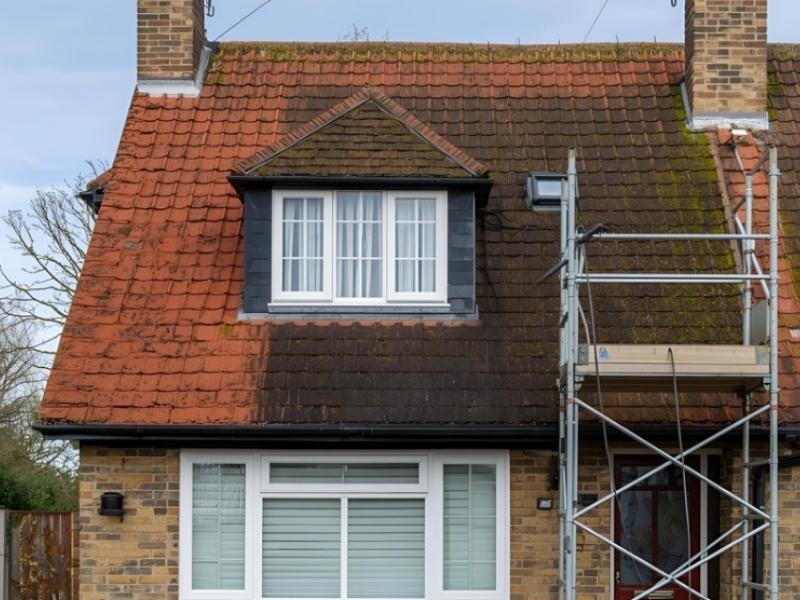
Environmental impact concerns many property owners. Roof steam cleaning is chemical free, making it the preferred option for eco conscious homeowners wanting environmentally friendly solutions. The cleaning process uses only hot water, with no chemical solutions that might run off into gardens.
Scraping itself creates no chemical waste, but the method usually pairs with chemical treatments to prevent regrowth. These require careful handling and disposal. For properties with sensitive landscaping, this creates complications that eco friendly approaches avoid.
Beyond chemicals, steam cleaning's longer lasting results mean fewer cleaning sessions over the roof's lifespan. This reduces carbon footprint from repeated visits and waste from damaged tiles requiring replacement.
Some roofs present unique challenges. Stubborn moss colonies that have grown for years need aggressive treatment. Roof scraping can remove thick buildup quickly, but without follow up treatment, regrowth happens fast, leading many homeowners to wonder how to stop moss growing on your roof in the long term.
Pressure washing sits between these two main methods. Some professionals use pressure washer equipment, but high pressure water can force moisture under tiles and damage fragile materials. Roof pressure washing works for resilient surfaces but risks harm to older roofs or delicate tile types.
Turbo nozzle attachments increase pressure washer effectiveness for removing dirt and grime. However, these tools still carry risks of tile damage and water ingress that other methods avoid.
The cleaning process you choose should match your roof's condition. Heavily affected roofs benefit from thorough steam treatment. Lightly soiled surfaces might manage with scraping and biocide treatment as a cost effective alternative.
Several factors influence which method suits your needs. Budget constraints might push you toward roof scraping as a faster, cheaper upfront method. Time consuming steam cleaning costs more initially but delivers long term benefits through extended protection. For many homeowners wondering is it a good idea to have the roof cleaned, these differences highlight how each option offers distinct advantages.
Property plans matter too. Homeowners selling soon often choose scraping for quick curb appeal improvement. Those staying long term benefit from steam cleaning's durability and reduced roof maintenance requirements.
Professional assessment clarifies the best path. We examine roof types, extent of moss and algae coverage, previous roof damage, and your maintenance goals. Different properties need different approaches based on material, age, and condition.
Professional roof cleaning ensures safety and effectiveness. Experienced teams understand how different roof materials respond to various cleaning methods. They know when to use gentle low pressure techniques and when more aggressive manual removal is appropriate.
Professional roof services also carry insurance protection. If something goes wrong during cleaning, you're covered. DIY attempts leave you liable for any damage to your property or injuries sustained.
Quality teams also spot potential problems early. During the cleaning process, professionals identify cracked tiles, damaged flashing, or other issues that could lead to costly repairs if ignored. This preventative approach protects your investment.
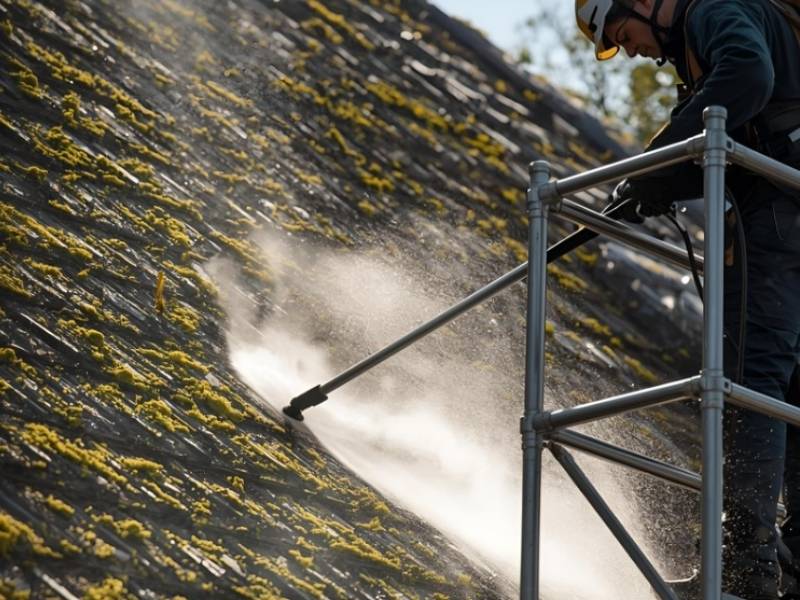
Choosing between roof steam cleaning and the scraping method depends on your specific circumstances. Both cleaning methods have roles in roof maintenance. Scraping offers quick visual results at lower initial cost. Steam cleaning provides longer lasting protection with minimal risk to tiles.
We've helped homeowners and commercial property owners across Newcastle make informed decisions based on individual needs. Our professional roof team assesses each property individually, considering roof material, current condition, budget, and goals.
Don't let moss and algae shorten your roof's lifespan or lead to expensive repairs. Contact Roof Cleaning Newcastle today for a free quote. We'll inspect your roof types, discuss which cleaning methods suit your needs, and provide a detailed estimate with no obligation. Our professional roof cleaning service ensures your property maintains aesthetic appeal, prevents water ingress, and remains protected for years to come.